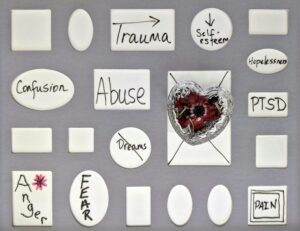
Caption: Healing from trauma and and eating disorders is a journey of navigating pain, fear, and self-discovery. Every step toward self-compassion matters. ❤️ #TraumaHealing #MentalHealthAwareness
🔹 “I feel like my body and I are speaking different languages.”
🔹 “I want to trust my body, but I don’t know how.”
🔹 “I feel completely disconnected from myself.”
Healing the Mind-Body Disconnect
If any of these thoughts resonate with you, you’re not alone. Trauma—especially when intertwined with an eating disorder—often creates a deep disconnect between mind and body. You may feel like your body has betrayed you, or that you need to control it in order to feel safe. But true healing starts with rebuilding trust with your body after trauma—not by punishing or ignoring it, but by learning to listen to it again.
Why Trauma Disrupts the Mind-Body Connection
When we experience trauma, our nervous system reacts by going into survival mode—fight, flight, freeze, or fawn. In order to cope, we might:
✔️ Numb sensations in our body to avoid pain
✔️ Distrust hunger, fullness, or emotional signals
✔️ Seek control over food, weight, or exercise to regain a sense of power
✔️ Feel unsafe or uncomfortable being present in our own skin
These responses aren’t failures—they’re protective mechanisms that once helped you survive. But in recovery, the goal shifts from survival to reconnection.
Three Gentle Steps to Healing the Mind-Body Disconnect
1. Practice Body Awareness Without Judgment
Start small. Instead of overwhelming yourself with how you feel about your body, focus on what you feel in your body.
Try this:
- Close your eyes and take a deep breath.
- Notice one neutral sensation—maybe the temperature of the air on your skin or the feeling of your feet on the ground.
- Resist the urge to judge or change anything. Just notice.
This practice helps rebuild your ability to tune into your body without fear or criticism.
2. Validate Your Body’s Signals
Your body is always communicating with you. The challenge is learning to trust its messages again.
A simple way to practice:
- When you feel hungry, honor it with nourishment.
- When you feel tired, allow yourself to rest.
- When you feel tension, stretch or breathe deeply.
Each time you acknowledge your body’s needs, you reinforce that it is safe to listen.
3. Shift from Control to Curiosity
Eating disorders often reinforce the belief that we must control our bodies in order to decrease anxiety and tension. Instead, try approaching your body with curiosity.
Instead of: “I need to ignore my hunger or cravings.”
Try: “What is my body asking for right now?”
Instead of: “I can’t trust my body.”
Try: “What if my body is trying to help me?”
Curiosity opens the door to healing—without the pressure of perfection.
Ready to Take the Next Step?
Rebuilding trust with your body after trauma takes time, but you don’t have to do it alone.
📥 Download the free Mind-Body Healing Toolkit for guided exercises, journal prompts, and grounding techniques to help you feel safe in your body again. https://guarascio-psychological-services-llc.kit.com/79c40aa5f3



